East Village at Knutsford: A Case Study in Sustainable Urbanism
Abstract
1. Introduction
1.1. Background
1.2. Living Laboratories
1.3. Case Study
2. Methods: Development Design Features
2.1. Development Intention
- Net Zero Energy Homes that produce more energy than they use over an average year, while achieving high levels of comfort and amenity. These will be all-electric homes, with no reticulated gas supply being connected to the development.
- A Net Zero Energy Development, meaning that the annual average energy production at EVK should exceed the annual average consumption.
- A 100% renewable energy development, meaning that all electricity used onsite is to be from renewable sources. This includes onsite energy systems (in this case, rooftop solar photovoltaic systems) and electricity sourced from the grid. Because there is no renewable gas supply available to the site, or more widely, and because there is never likely to be such a supply, gas connection was ruled out.
- A largely energy-self-reliant development, meaning that dwelling and common services energy requirements are sourced from onsite generation systems as much as is practical and commercially viable.
- An Electric Vehicle (EV)-ready development that allows for the home charging of EVs. The electrical design allows for vehicle charging at the high end of home-charging rates, and the energy requirements of EVs have been considered in the setting of the targets and objectives for the project (with provision for electric bicycles and scooters as part of the overall strategy).
- Reducing reliance on mains water supply as much as is practical.
- A landscape design that supports the above objectives while also achieving best practice in urban greening, including seasonal shading, food production and wildlife habitats.
2.2. Delivery Innovations
2.3. Built Form Innovations
2.4. Energy Innovations
Modelling to Verify Energy Strategies
- The NatHERS tool is used as a standard compliance pathway for dwellings to comply with the energy efficiency requirements of the Australian National Construction Code but can also be used to analyse designs and identify opportunities to improve performance or required changes to achieve a target.
- Precinct energy modelling: A bespoke energy model was developed to allow detailed scenario analysis and to be able to test a variety of financial models. The parameters were then run in the HOMER platform (developed by the US National Renewable Energy Laboratory) to confirm that the key results were consistent.
2.5. Water Innovations
2.6. Landscaping Innovations
3. Results: Modelled Performance
3.1. Energy
- Common lighting and water pumping loads.
- Electric vehicle charging loads.
- Dwelling design and systems choices, such as the 7.5-star NatHERS rating [46] and the use of efficient appliances, including air-sourced heat-pump hot water systems and induction cooktops, reducing electricity requirements by around 35% from the local average.
- Solar PV systems meet loads directly while the sun is shining and, because of the embedded network, energy can be exported directly to neighbours. Electricity imports are reduced by up to 26%. Without a battery, around 60% of the PV electricity generated on site would be unused and typically exported to the grid, if such feed-in was permitted.
- The battery system enables the renewable energy produced on the site to be stored and drawn on when required by households within the embedded network. Grid reliance is expected to be approximately 20% in winter months.
3.2. Water
- Savings in the order of 25% brought about through reduced lot sizes compared to the Perth average resulting in reduced irrigation volumes.
- Improved water-use efficiency, including better-performing internal water fixtures and efficient irrigation, as well as efficient water-use behaviour and leak detection supported by smart metering, leading to a further 25% reduction.
- The use of alternate water sources including rainwater and sustainably managed groundwater to substitute mains water by around 30%.
3.3. Cost Comparisons
4. Discussion and Conclusions
Author Contributions
Funding
Acknowledgments
Conflicts of Interest
References
- United Nations Global Indicator Framework for the Sustainable Development Goals and Targets of the 2030 Agenda for Sustainable Development. Available online: https://unstats.un.org/sdgs/indicators/indicators-list/ (accessed on 6 July 2020).
- IPCC. Climate Change 2014 Mitigation of Climate Change Working Group III Contribution to the Fifth Assessment Report of the Intergovernmental Panel on Climate Change; Edenhofer, O., Sokona, Y., Minx, J.C., Farahani, E., Kadner, S., Seyboth, K., Adler, A., Baum, I., Brunner, S., Kriemann, B., et al., Eds.; Cambridge University Press: Cambridge, MA, USA; New York, NY, USA, 2014; ISBN 9781107654815. [Google Scholar]
- Newton, P.W.; Rogers, B.C. Transforming built environments: Towards carbon neutral and blue-green cities. Sustainability 2020, 12, 4745. [Google Scholar] [CrossRef]
- Van Der Grijp, N.; Van Der Woerd, F.; Gaiddon, B.; Hummelshøj, R.; Larsson, M.; Osunmuyiwa, O.; Rooth, R. Demonstration projects of nearly zero energy buildings: Lessons from end-user experiences in Amsterdam, Helsingborg, and Lyon. Energy Res. Soc. Sci. 2019, 49, 10–15. [Google Scholar] [CrossRef]
- Newton, P.; Prasad, D.; Sproul, A.; White, S. Decarbonising the Built Environment: Charting the Transition; Palgrave Macmillan US: Singapore, Singapore, 2019; ISBN 9789811379406. [Google Scholar]
- Rowley, S.; Ong, R.; James, A. Perth’s Infill Housing Future: Delivering Innovative and Sustainable Housing; Curtin University: Perth, Australia, 2017. [Google Scholar]
- Ameller, J.; Rinaudo, J.; Merly, C. The contribution of economic science to brownfield redevelopment: A review. Integr. Environ. Assess. Manag. 2020, 16, 184–196. [Google Scholar] [CrossRef] [PubMed]
- von Wirth, T.; Fuenfschilling, L.; Frantzeskaki, N.; Coenen, L. Impacts of urban living labs on sustainability transitions: Mechanisms and strategies for systemic change through experimentation. Eur. Plan. Stud. 2019, 27, 229–257. [Google Scholar] [CrossRef]
- Sherriff, G.; Moore, T.; Berry, S.; Ambrose, A.; Goodchild, B.; Maye-banbury, A. Coping with extremes, creating comfort: User experiences of ‘low-energy’ homes in Australia. Energy Res. Soc. Sci. 2019, 51, 44–54. [Google Scholar] [CrossRef]
- Wiktorowicz, J.; Babaeff, T.; Breadsell, J.; Byrne, J.; Eggleston, J.; Newman, P. WGV: An Australian urban precinct case study to demonstrate the 1.5C agenda including multiple SDGs. Urban Plan. 2018, 3, 64–81. [Google Scholar] [CrossRef]
- Energy transformation taskforce. In Distributed Energy Resources Roadmap; Government of Western Australia: Perth, Australia, 2019.
- Wilkinson, S.; Davidson, M.; Morrison, G.M. Historical transitions of Western Australia’s electricity system, 1880-2016. Environ. Innov. Soc. Transit. 2020, 34, 151–164. [Google Scholar] [CrossRef]
- Baborska-Narozny, M.; Stevenson, F.; Ziyad, F.J. User learning and emerging practices in relation to innovative technologies: A case study of domestic photovoltaic systems in the UK. Energy Res. Soc. Sci. 2016, 13, 24–37. [Google Scholar] [CrossRef]
- Whaley, D.; Berry, S.; Moore, T.; Sherriff, G.; O’Leary, T. Resident’s issues and interactions with grid-connected photovoltaic energy system in high-performing low-energy dwellings: A user’s perspective. In Proceedings of the 10th International Conference in Sustainability of Energy and Buildings (SEB’18); Kaparaju, P., Howlett, R.J., Littlewood, J.R., Ekanyaka, C., Vlacic, L., Eds.; Springer: Cham, Switzerland, 2019; pp. 413–424. [Google Scholar]
- Talari, S.; Shafie-Khah, M.; Siano, P.; Loia, V.; Tommasetti, A.; Catalão, J.P.S.; Tah, J.H.M. A review of smart cities based on the internet of things concept. Energies 2017, 10, 421. [Google Scholar] [CrossRef]
- Han, J.; Yoon, Y.; Han, K. Urban planning and smart city decision data processing using big data analytics. Sensors 2018, 18, 2994. [Google Scholar]
- Alam, M.; Porras, J. Architecting and designing sustainable smart city services in a living lab environment. Technologies 2018, 6, 99. [Google Scholar] [CrossRef]
- Tjandraatmadja, G. The role of policy and regulation in WSUD implementation. In Approaches to Water Sensitive Urban Design: Potential, Design, Ecological Health, Urban Greening, Economics, Policies and Community Perceptions; Sharma, A.K., Gardner, T., Begbie, D., Eds.; Elsevier: Amsterdam, The Netherlands, 2019; pp. 87–117. [Google Scholar]
- Mouritz, M.J. Sustainable Urban Water Systems: Policy and Professional Praxis; Murdoch University: Murdoch, Australia, 1996. [Google Scholar]
- Approaches to Water Sensitive Urban Design: Potential, design, Ecological Health, Urban Greening, Economics, Policies, and Community Perceptions; Sharma, A.K., Gardner, T., Begbie, D., Eds.; Elsevier: Amsterdam, The Netherlands, 2018. [Google Scholar]
- Byrne, J.; Green, M.; Dallas, S. WSUD implementation in a precinct residential development: Perth case study. In Approaches to Water Sensitive Urban Design: Potential, Design, Ecological Health, Urban Greening, Economics, Policies and Community Perceptions; Sharma, A.K., Gardner, T., Begbie, D., Eds.; Elsevier: Amsterdam, The Netherlands, 2018; pp. 541–559. [Google Scholar]
- McFarlane, D. Will perth have enough water for its diverse needs in a drying climate? In Planning Boomtown and Beyond; Beirmann, S., Olaru, D., Paul, V., Eds.; UWA Press: Perth, Australia, 2016; pp. 209–237. [Google Scholar]
- Rogers, B.; Hammer, K. Realising the Vision of a Water Sensitive City. Available online: https://www.thesourcemagazine.org/realising-the-vision-of-a-water-sensitive-city/ (accessed on 7 July 2020).
- Liedtke, C.; Baedeker, C.; Hasselkuß, M.; Rohn, H.; Grinewitschus, V. User-integrated innovation in Sustainable Living Labs: An experimental infrastructure for researching and developing sustainable product service systems. J. Clean. Prod. 2015, 97, 106–116. [Google Scholar] [CrossRef]
- Chronéer, D.; Ståhlbröst, A.; Habibipour, A. Urban living labs: Towards an integrated understanding of their key components. Technol. Innov. Manag. Rev. 2019, 9, 50–62. [Google Scholar] [CrossRef]
- Burbridge, M.; Morrison, G.M.; van Rijin, M.; Silverster, S.; Keyson, D.V.; Virdee, L.; Baedeker, C.; Liedtke, C. Business models for sustainability in living labs. In Living Labs Design and Assessment of Sustainable Living; Keyson, D.V., Guerra-Santin, O., Lockton, D., Eds.; Springer International Publishing: Cham, Switzerland, 2017; pp. 391–403. [Google Scholar]
- Leminen, S.; Westerlund, M. Towards innovation in living labs networks. Int. J. Prod. Dev. 2012, 17, 43–59. [Google Scholar] [CrossRef]
- Zou, P.X.W.; Xu, X.; Sanjayan, J.; Wang, J. Review of 10 years research on building energy performance gap: Life-cycle and stakeholder perspectives. Energy Build. 2018, 178, 165. [Google Scholar] [CrossRef]
- Gram-Hanssen, K.; Georg, S.; Christiansen, E.; Heiselberg, P. What next for energy-related building regulations? The occupancy phase. Build. Res. Inf. 2018, 46, 790–803. [Google Scholar] [CrossRef]
- Closing the Gap between Design & As-Built Performance Evidence Review; Zero Carbon Hub: London, UK, 2014.
- Berry, S.; Davidson, K.; Saman, W. The impact of niche green developments in transforming the building sector: The case study of Lochiel Park. Energy Policy 2013, 62, 646–655. [Google Scholar] [CrossRef]
- Breadsell, J.; Morrison, G.M.; Byrne, J. Pre- and post-occupancy evaluation of resident motivations for and experiences of establishing a home in a low-carbon development. Sustainability 2019, 11, 3970. [Google Scholar] [CrossRef]
- Byrne, J.; Law, A.; Hosking, R.; Breadsell, J.; Syed, M.; Babaeff, T.; Morrison, G.; Newman, P. Mainstreaming Low Carbon Residential Precincts: The WGV Living Laboratory; CRC for Low Carbon Living: Sydney, Australia, 2019. [Google Scholar]
- LandCorp Innovation through Demonstration: WGV. Available online: https://www.landcorp.com.au/innovation/wgv/ (accessed on 21 May 2020).
- Roggema, R. The future of sustainable urbanism: A redefinition. City Territ. Archit. 2016, 3, 22. [Google Scholar] [CrossRef]
- Breadsell, J.K.; Byrne, J.J.; Morrison, G.M. Household energy and water practices change post-occupancy in an Australian low-carbon development. Sustainability 2019, 11, 5559. [Google Scholar] [CrossRef]
- Bioregional East Village on Knutsford–Creating a Better Model of Housing for Australia. Available online: https://www.bioregional.com/bioregional-australia/bioregional-australia-our-work/east-village-knutsford-creating-a-better-model-of-housing-for-australia (accessed on 9 May 2020).
- DevelopmentWA Innovation through Demonstration. Available online: https://developmentwa.com.au/itd (accessed on 9 May 2020).
- Green, J.; Newman, P. Planning and governance for decentralised energy assets in medium-density housing: The WGV gen Y case study. Urban Policy Res. 2017, 1146, 201–214. [Google Scholar] [CrossRef]
- Breadsell, J.; Morrison, G.M. Changes to household practices pre- and post-occupancy in an Australian low-carbon development. Sustain. Prod. Consum. 2020, 22, 147–161. [Google Scholar] [CrossRef]
- Green, J.; Morrison, G. Citizen Utilities: Unlocking Australian Strata Development to the Benefits of Solar and Battery Storage Innovations: A Report for the Australian Renewable Energy Agency; Curtin University: Perth, Australia, 2018. [Google Scholar]
- Hansen, P.; Morrison, G.M.; Zaman, A.; Liu, X. Smart technology needs smarter management: Disentangling the dynamics of digitalism in the governance of shared solar energy in Australia. Energy Res. Soc. Sci. 2020, 60, 101322. [Google Scholar] [CrossRef]
- Landgate Survey or Strata Plans. Available online: https://www0.landgate.wa.gov.au/titles-and-surveys/survey-or-strata-plans (accessed on 30 May 2020).
- Pacifici, C. Greening Strata Title Schemes in Western Australia Greening Strata Title Schemes in WA: Turning Barriers into Opportunities for Individual Owners to Implement Environmentally Sustainable Provisions in Existing Residential Strata Dwellings; Curtin University Sustainability Policy (CUSP) Institute: Perth, Australia, 2011. [Google Scholar]
- Knutsford Knutsford. Available online: https://www.knutsford.com.au/ (accessed on 21 May 2020).
- Department of Industry, Science, Energy and Resources. Nationwide House Energy Rating Scheme (NatHERS). Available online: https://www.nathers.gov.au/ (accessed on 28 April 2020).
- Power Ledger Power Ledger Reveals Australian Government Smart Cities Project for 100% Renewable Energy. Available online: https://www.powerledger.io/article/power-ledger-reveals-australian-government-smart-cities-project-for-100-renewable-energy/ (accessed on 28 April 2020).
- Wilkinson, S.; Hojckova, K.; Eon, C.; Morrison, G.M.; Sandén, B. Is peer-to-peer electricity trading empowering users? Evidence on motivations and roles in a prosumer business model trial in Australia. Energy Res. Soc. Sci. 2020, 66, 101500. [Google Scholar] [CrossRef]
- Enker, R.A.; Morrison, G.M. The potential contribution of building codes to climate change response policies for the built environment. Energy Effic. 2020, 13, 789–807. [Google Scholar] [CrossRef]
- Hunt, J.; Anda, M.; Ho, G. Water balance modelling of alternate water sources at the household scale. Water Sci. Technol. 2011, 63, 1873–1879. [Google Scholar] [CrossRef] [PubMed]
- Perth Residential Water Use Study 2008/2009; Water Corporation: Perth, Australia, 2010.
- Urban Forest Plan; City of Fremantle: Fremantle, Australia, 2017.
- Kinesis CCAP Precinct (PRECINX). Available online: https://kinesis.org/ccap-precinct (accessed on 14 July 2020).
- Mouritz, M. East Village: A Sustainable Urbanism Project by LandCorp; CRC for Low Carbon Living: Sydney, Australia, 2019. [Google Scholar]
- Lot 1819 Energy Strategy: Review of Energy Options and Outcomes; Josh Byrne & Associates: Fremantle, Australia, 2018.
- Urban Water Management Plan for Lot 1819 Blinco St, Fremantle; Josh Byrne & Associates: Fremantle, Australia, 2018.
- Breadsell, J.K.; Eon, C.; Morrison, G.M. Understanding resource consumption in the home, community and society through behaviour and social practice theories. Sustainability 2019, 11, 6513. [Google Scholar] [CrossRef]
- Torriti, J. Understanding the timing of energy demand through time use data: Time of the day dependence of social practices and energy demand. Energy Res. Soc. Sci. 2017, 25, 37–47. [Google Scholar] [CrossRef]
- Power Ledger Project Update: Fremantle Smart City Development. Available online: https://medium.com/power-ledger/project-update-fremantle-smart-city-development-b16ccce2eb8f (accessed on 9 June 2020).
- Power Ledger Power Ledger. Available online: https://www.powerledger.io/ (accessed on 9 May 2020).
- Breadsell, J.K.; Eon, C.; Byrne, J.; Morrison, G.M. Addressing the Discrepancy between as-Built and as-Designed in Australian Energy Efficient Buildings; IPEEC Building Energy Efficiency Task Group: Sydeny, Australia, 2020. [Google Scholar]
- Fabi, V.; Spigliantini, G.; Corgnati, S.P. Insights on smart home concept and occupants’ interaction with building controls. In Proceedings of the Energy Procedia; Elsevier: Amsterdam, The Netherlands, 2017; Volume 111, pp. 759–769. [Google Scholar]
- Paskaleva, K.; Evans, J.; Martin, C.; Linjordet, T.; Yang, D.; Karvonen, A. Data governance in the sustainable smart city. Informatics 2017, 4, 41. [Google Scholar] [CrossRef]
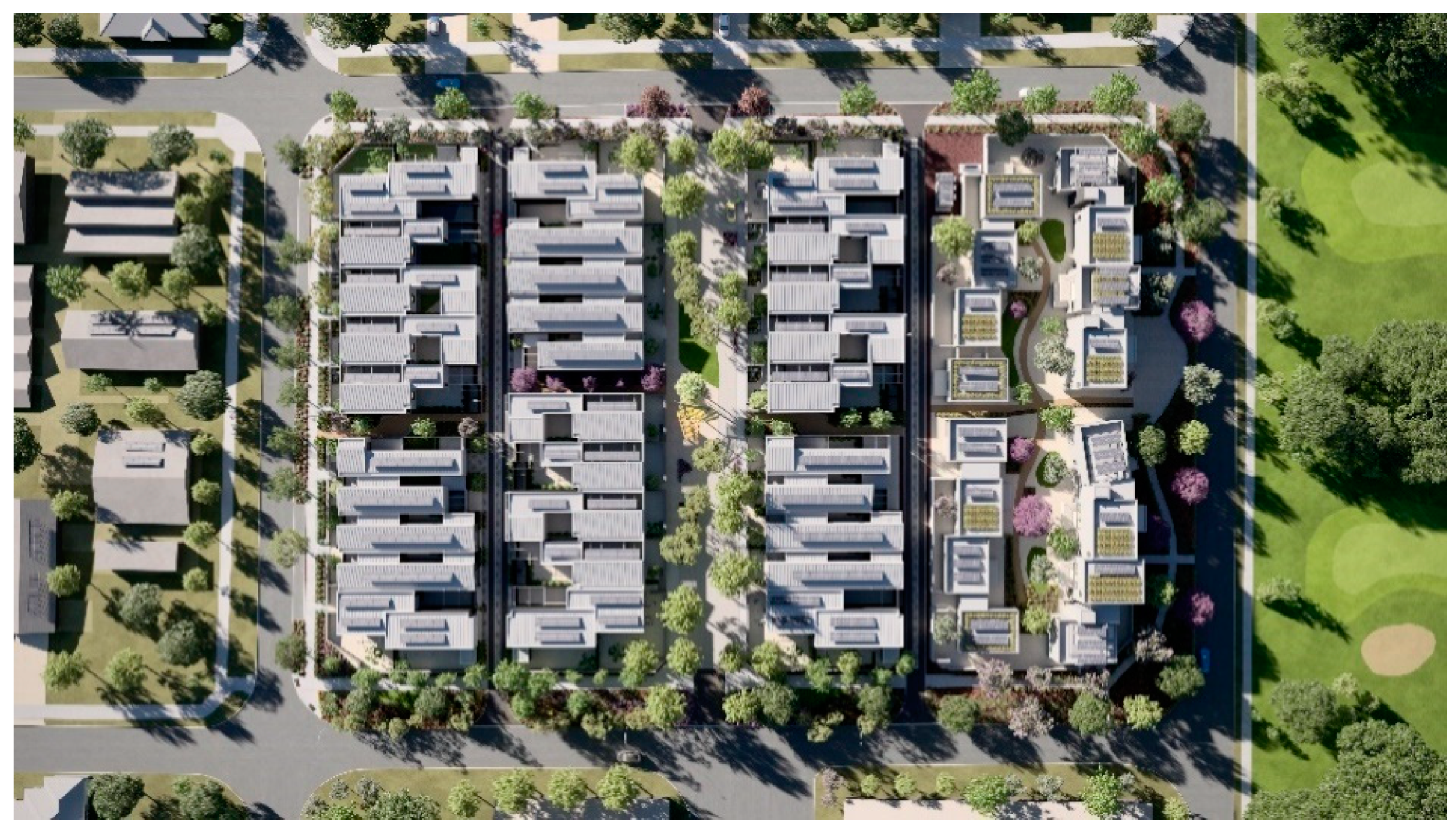
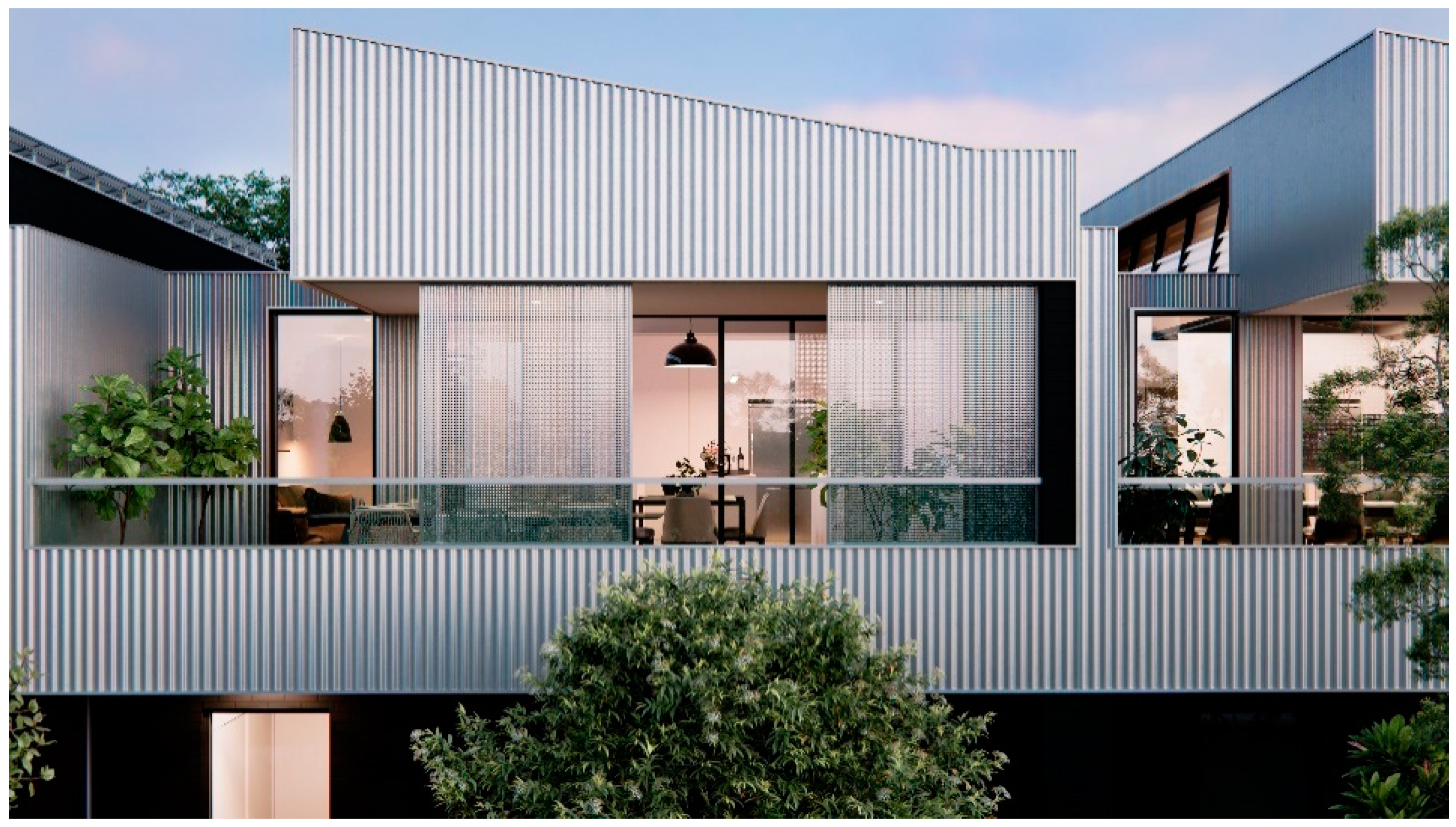
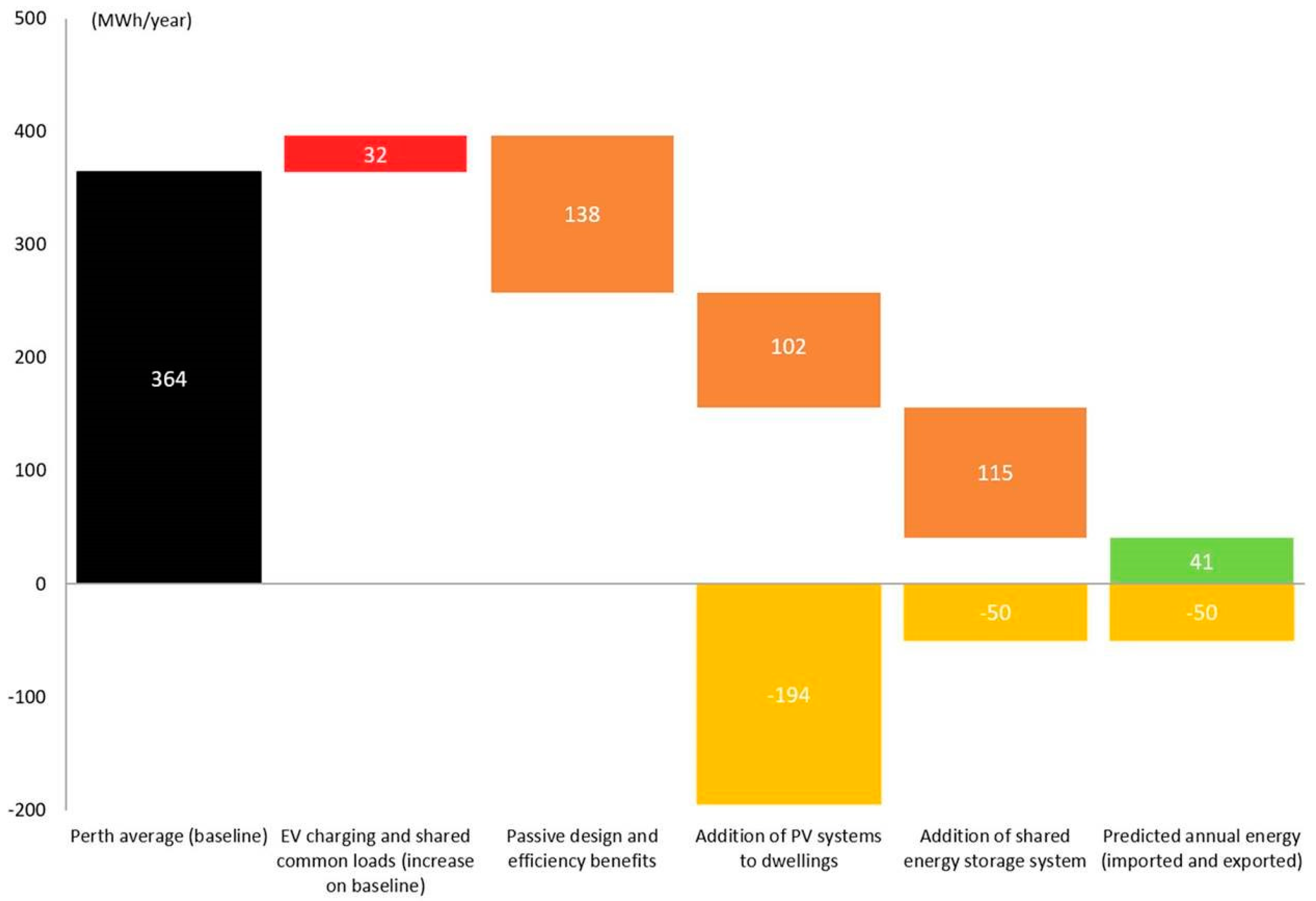
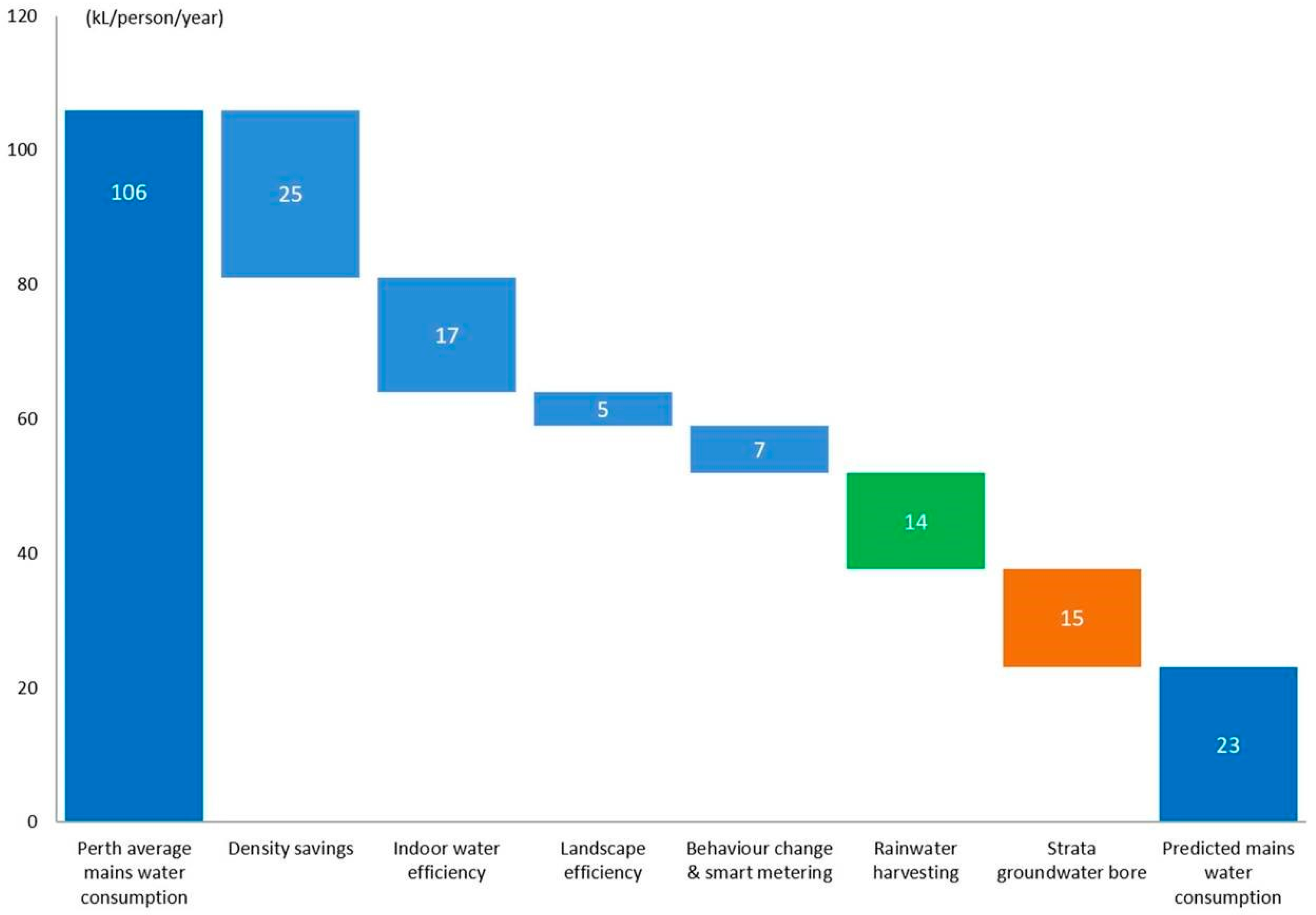
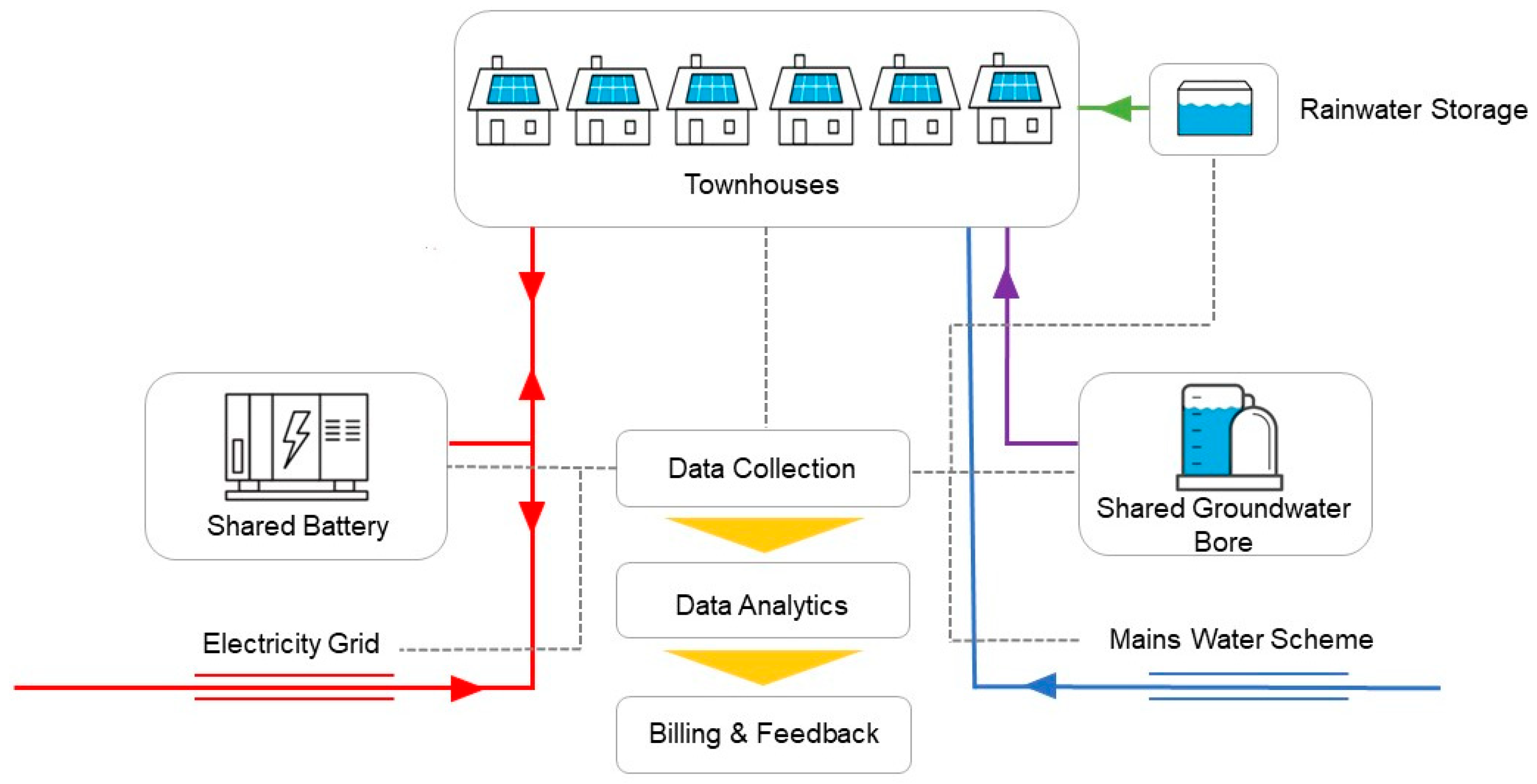
| ENERGY INITIATIVES | WGV | EVK |
| NatHERS rating * | 7 star minimum | 7.5 star minimum |
| Reticulated natural gas | Yes (optional connection) | No |
| Minimum solar PV per dwelling | 1.5 kW min. Upgraded to 3.5 kW via developer sustainability package | 6.6 kW PV with 5 kW inverter packaged with fully designed homes |
| Battery for energy storage | No site-level shared battery system | Shared 670 kWh battery for 36 townhouses and common services |
| Hot water | Solar Hot Water System or heat-pump water heater | Heat pump (5 star) packaged with fully designed homes |
| Air conditioning | Reverse cycle (3 star ** min.) | Ceiling fans installed in living areas No AC provided—can be added by owner if desired |
| Cooking | Not specified | Induction cooktop Electric oven |
| Electric Vehicle charging | Not specified | Dedicated circuit for home charging, plus public fast charger |
| Smart metering | Research phase only | Permanent strata owned embedded, remotely read metering network |
| Drying court | Mandatory | Provided |
| Shade tree | Deep root zone mandatory; tree provided via developer sustainability package | Provided |
| Lighting | LED or compact fluorescent | LED |
| MODELLED ENERGY USE REDUCTION | 80% | 80% |
| ACTUAL ENERGY USE REDUCTION | 54% + 20.5 kW/day export | To be verified once occupied |
| WATER INITIATIVES | WGV | EVK |
| Water-efficient fixtures beyond minimum compliance (using WELS *** ratings) | Yes Shower heads: 3 star (max. 7.5 L/min) Toilets: 4 star min. All other taps (exc. outdoor and bath): 4 star min. | Yes Shower heads: 3 star (max. 7.5 L/min) Toilets: 4 star min. All other taps (exc. outdoor and bath): 4 star min. |
| Water-efficient landscape requirements | Yes, including drip irrigation to garden beds, low-water-use plants, irrigation controller and soil conditioning | Yes, though likely to have greater control of outcomes as the landscape and irrigation installations will be installed by the builder |
| Rainwater harvesting | Dual plumbing required for toilet and washing machine, with min. 70 m2 roof catchment available to tank location; 3 kL tank plus pump and controls provided via developer sustainability package | 7 kL tank installed and connected to toilet, washing machine and hot water service; entire roof catchment connected (average 150 m2) |
| Shared non-drinking water supply (groundwater) | Community bore for irrigation only | Strata groundwater bore for irrigation and garden taps |
| WSUD stormwater controls | Yes | Yes, but more comprehensive due to strata ownership |
| MODELLED MAINS WATER USE REDUCTION | 70% | 80% |
| ACTUAL MAINS WATER USE REDUCTION | 48% | To be verified once occupied |
© 2020 by the authors. Licensee MDPI, Basel, Switzerland. This article is an open access article distributed under the terms and conditions of the Creative Commons Attribution (CC BY) license (http://creativecommons.org/licenses/by/4.0/).
Share and Cite
Byrne, J.; Mouritz, M.; Taylor, M.; Breadsell, J.K. East Village at Knutsford: A Case Study in Sustainable Urbanism. Sustainability 2020, 12, 6296. https://doi.org/10.3390/su12166296
Byrne J, Mouritz M, Taylor M, Breadsell JK. East Village at Knutsford: A Case Study in Sustainable Urbanism. Sustainability. 2020; 12(16):6296. https://doi.org/10.3390/su12166296
Chicago/Turabian StyleByrne, Joshua, Mike Mouritz, Mark Taylor, and Jessica K. Breadsell. 2020. "East Village at Knutsford: A Case Study in Sustainable Urbanism" Sustainability 12, no. 16: 6296. https://doi.org/10.3390/su12166296
APA StyleByrne, J., Mouritz, M., Taylor, M., & Breadsell, J. K. (2020). East Village at Knutsford: A Case Study in Sustainable Urbanism. Sustainability, 12(16), 6296. https://doi.org/10.3390/su12166296






